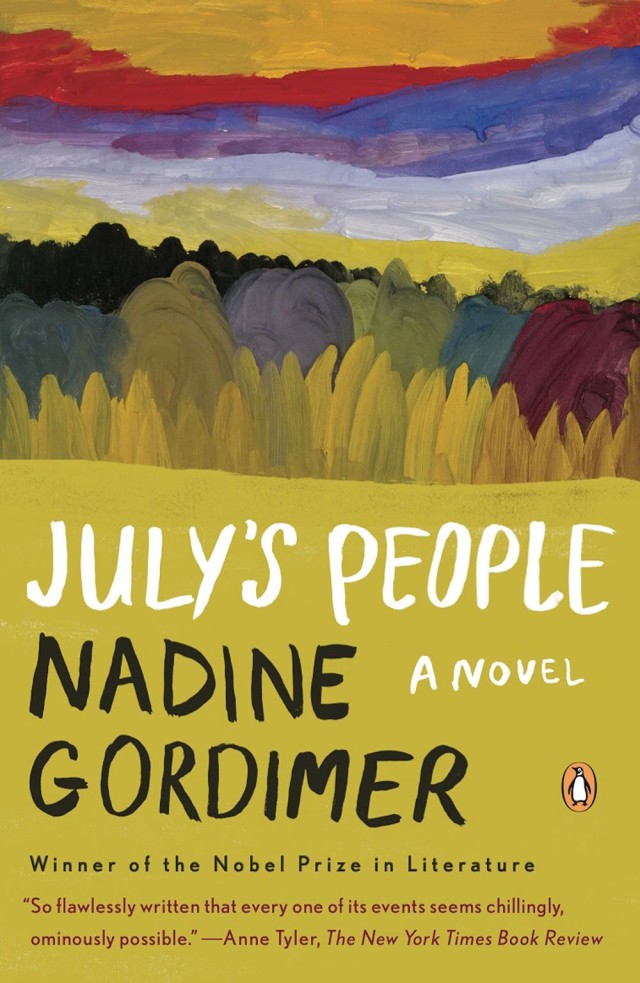July’s People
by Nadine Gordimer
"Contemporary Reviews" Review
Published in 1981, Gordimer’s July’s People did not fail in receiving mixed responses. While a handful of writers felt that the novel was set in “the near and recognizable future,” it seemed only matter of time before a “black” revolution erupted in South Africa. Paul Grey of Time Magazine began his article with calling the novel’s future to be “inevitable.” And while some argued that the revolution was what drove the novel into the ground, others believed very “little actually happens on the surface,” urging that at its core, July’s People’s “demonstrates the tension and complex interdependencies between whites and blacks in South Africa,”(Tyler 1981) through a very specific example of a white liberal family. It is only when finding safety from the horrors of revolution through their black servant July, that the roles of power quickly change. The novel also ties in conversation about gender; observing the hostility that takes place between Bam and Maureen as husband and wife as well as between July and Maureen. Interestingly enough I was not able to find any articles or reviews from South Africa about the book. All the reviews I managed to find were from the months following the novel’s publication, none of which touched on the actual situation in South Africa during 1981.
While some reviewers such as Chettle felt that Gordimer’s novel “never seems to grapple seriously with the question she has raised,” others understood the novel to be without sympathy, and therefore without bias. Tyler writes in her article from the New York Times: “this level succeeds so extraordinary because of the Smaleses’ liberalism. It would have been too easy to make them racist. . .” instead they are put in a very conflicted position where there principles and fears as a white family in Africa change as their time amongst July’s people grows. It is Gordimer’s lack of sympathy that allows for her to “expose the hypocrisy” of her characters and it’s this blunt level of honesty that doesn’t allow for a false hope. It is also this characteristic that allows a character such as July to be justified and yet according to Jacoby held in “a prejudiced fear. . . our readiness to think the worst of the black man.”
As the couple becomes fully aware of their dependence in July, their hope for a new start is attached with the constant struggle between using their liberalism for convenience, as in for safety within July’s walls or a” reassuring pretense, as an attempt to appease their own guilt” (Jacoby 706) and yet both Bam and Maureen are aware of the consequences. “They had fled the fighting in the streets, the danger for their children, the necessity to defend their lives in the name of ideals they didn’t share in a destroyed white society they didn’t believe in.” It’s this and more that makes the novel the success it is. As Gray writes: “her vision breaks through the color barrier to encompass both sides. She shows how individual acts of kindness can override institutional injustice.” Gordimer doesn’t limit or censor herself in what she feels is a truth about racial distinction. In portraying the struggle of this white family the reader comes to a realization that both Smales and July alike are “trapped by their past. . .” and that “the best will in the world cannot save them. . .” (Jacoby 706).
Discussion Questions
- Having to flee to safety with July, does this actually reverse roles and put Maureen and Bam at the mercy of July, or is he still more like their servant?
- Why do you think the Smaleses’ children were able to adapt to the inverted racial situation easier than the adults?
- July’s wife is rather indignant about the arrival of the Smaleses; she indicates her disbelief at them not having anywhere to go, despite how having so many rooms they have in their house. How does this, and other parts of the book, vividly illustrate the class differences between the two families?
- How does the image of Maureen and Lydia, paired in the context of the photographer, change from what Maureen believed? Why is that?
- Can connections be drawn between the world created in this book and worlds created in dystopian novels?
- How does Maureen running to the unidentified helicopter at the end represent her being unable to cope with the situation of suddenly being the inferior race?
